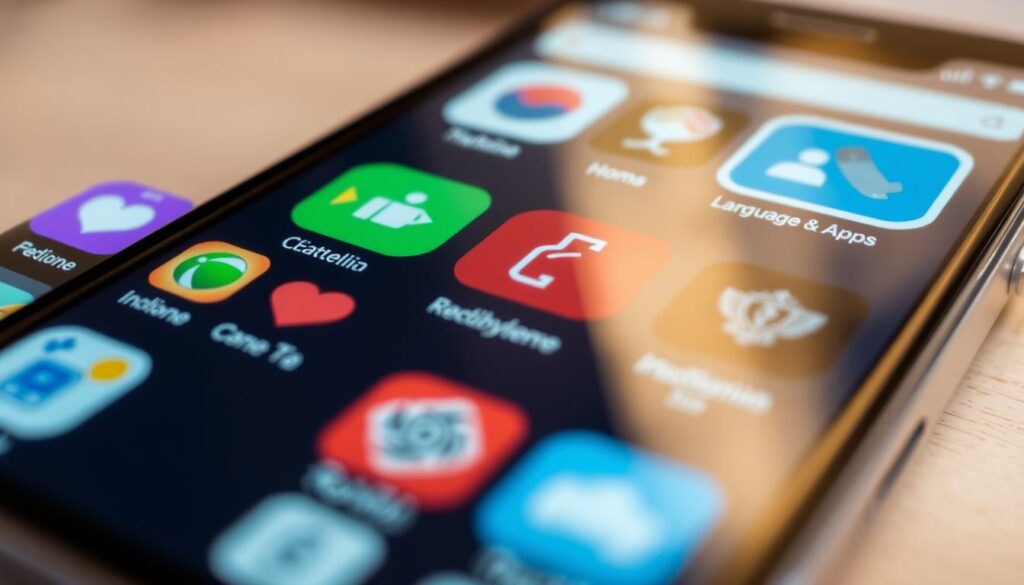Anúncios
Today, technology can really boost your language skills. There are lots of language learning apps to choose from. These apps meet different needs and can make your language fluency better.
This guide looks at the best language learning apps because of their unique qualities and effectiveness. Whether you like fun, game-style learning on Duolingo or structured lessons like on Lingoda, you’ll find helpful tips here. This article will help you improve your language skills greatly.
Anúncios

Top Language Learning Apps for Quick Mastery
Why Language Learning Apps Are Essential
Language learning apps have changed how we learn new languages. They let users learn at their own pace. This easy access is what makes them so helpful.
Convenience and Accessibility
Being able to learn anytime, anywhere is a big plus of these apps. Whether you’re on a bus, at home, or waiting in line, you can practice. This makes fitting learning into your life easier.
Engaging Learning Methods
Apps use fun ways to keep learners interested. With games, simulations, and interactive tasks, learning becomes fun. Enjoying the process encourages users to keep going.
Variety of Languages Offered
There’s a huge choice of languages on these apps. From popular ones like Spanish and Mandarin to less common dialects. This lets users pick a language that truly interests them, making learning more personal.

Duolingo: The Popular Choice
Duolingo stands out in language learning apps thanks to its fresh approach. It makes learning fun through gamification. This keeps users coming back for more. They aim to maintain streaks, win badges, and rise in rankings. This approach encourages regular practice and effort.
Gamification Features
Gamification turns study time into fun, interactive play. Earning rewards and leveling up give users a feeling of success. Competitive quizzes and daily challenges urge friends to beat each other’s scores. This makes them eager to keep learning more.
Free vs. Paid Options
Duolingo offers lots of content for free, giving access to many languages and activities. There’s also a paid version for those who want more. This version removes ads and includes extras like lessons offline. It helps meet various learning styles and needs.
Recent AI Integrations
Recently, Duolingo added new AI features to improve user involvement. Users can now talk with fictional characters. This allows for practicing in lifelike scenarios. Plus, new courses were added for beginners, making learning even richer.
Babbel: Best for Real-World Conversations
Babbel shines as a top app for those wanting to boost their speaking abilities. It’s great for real-life language use, teaching key words and phrases needed in daily conversations.
Focus on Speaking Skills
Babbel is dedicated to improving speaking skills. It uses interactive exercises to help users work on their pronunciation and chatting skills. These activities mimic actual conversations, making it easier for learners to speak confidently in real situations. This method moves users from just knowing words to actually using them.
Content Variety
Babbel offers a wide array of topics, making learning diverse and interesting. It has something for everyone, fitting various interests. The courses are organized by skill level, so all learners can find something suitable. Whether it’s for work or travel, Babbel has you covered for any conversation.
Lingoda: The Classroom Experience
Lingoda changes how we learn languages with fun and engaging classes. You can choose from one-on-one or small group lessons. These options let you talk directly with experienced teachers, which is key to really learning. Also, you can pick class times that fit your life, making learning easy and enjoyable for everyone no matter their skill level.
One-on-One Lessons
Lingoda’s one-on-one lessons are a standout feature. They offer personalized teaching, so you can work on what you need. In these lessons, you’re encouraged to speak up, helping you remember words better. This focus on you makes Lingoda different from other language platforms.
Structured Curriculum
Lingoda has a clear plan to help you learn a new language. They use detailed PDFs in every course to make learning better. This way is great for beginners or those wanting to keep up their language skills. With a step-by-step approach, students feel more confident as they improve.
Pimsleur: Audio Learning for Effective Communication
Pimsleur is a top choice for improving language skills through audio learning. It mainly aims to boost listening and speaking skills. These are vital for communicating well in any language. Pimsleur’s unique teaching method uses repetition and recall. This helps learners gain real conversational abilities.
Listening and Speaking Emphasis
At the heart of the Pimsleur method is a focus on listening and speaking. Users actively listen to the audio, helping them remember words and phrases better. They’re encouraged to speak out loud, which is great for learning. This method is especially good for people who learn by hearing. It helps them get pronunciation and conversational flow down.
Availability of Multiple Languages
Pimsleur is appealing because it offers a wide selection of languages. It’s designed for various learners, letting people study many languages easily. Each course aims to make learners fluent. With Pimsleur, you can start learning a new language without limits. Plus, you get to improve your listening and speaking abilities.
Fluenz: Instructor-Led Learning
Fluenz shines as a top choice for those wanting structured, teacher-led study. It brings the feel of a classic classroom to life. This method offers a solid education framework that builds your language abilities well.
Comprehensive Learning Approach
Fluenz is known for its full learning method. It starts with the basics, making sure you get a solid foundation. The lessons are tailored to keep you focused and help you remember what you learn better. Its mix of interactive learning and real-world use is great for starters.
Limited Language Selection
Though Fluenz gives a strong study experience, it’s limited in language options. It mainly offers languages like Spanish, French, and Mandarin, focusing on English speakers. Think about if the few language choices suit your needs before you choose this app.
Rosetta Stone: Iconic Language Learning Solution
Rosetta Stone stands out as a top choice for learning languages. It uses an immersive method that makes learning feel natural. Learners get to see words and grammar used in real-life situations. This helps them move through different levels of learning smoothly.
Immersive Learning Environment
This method focuses on real-life use rather than just memorizing. It helps learners understand the diversity of languages better. Plus, they get to feel more at home with the language they’re learning.
Beginning to Advanced Language Skills
Rosetta Stone works for all learners, whether they’re starting out or already advanced. It has lots of resources that match how well you know the language. As you get better, the platform helps you practice more and improve your skills.
Mondly: Innovative Technology Meets Learning
Mondly stands out by using new technology for language learning. It offers augmented reality and virtual reality, making lessons interactive. This is different from normal language classes.
This method grabs the user’s attention and helps them understand the language better. Mondly includes an intelligent chatbot for practice. This lets users have real-time talks, like they would in real life.
This advanced tech boosts the learning journey. It makes Mondly a top choice in modern language learning.
Language Learning Apps: A Multi-Resource Approach
Language learning apps are a great start to learn a new language. Adding different kinds of language tools can make learning even better. By using a variety of resources and real materials, learners improve faster and understand the culture better.
Complementing Apps with Other Resources
To learn a language well, it’s key to use more than just apps. This means reading books, taking online courses, or talking with native speakers. Using these extra tools helps strengthen what apps teach and helps use the language in real life.
Utilizing Authentic Materials
Using real-life materials like movies, music, and podcasts in the language you’re learning is super helpful. These things help you understand how the language is used every day. They also teach you about the culture and make learning more fun and engaging.
Conclusion
The world of language learning apps is filled with choices for different types of learners. Whether you like playing games while learning with Duolingo or prefer a more class-like setting with Lingoda, there’s an app for you. Choosing the right app depends on what fits best with how you like to learn.
The need for good language learning tools is increasing. Apps like Rosetta Stone and Mondly offer fun ways to learn. They use unique methods to help learners improve their fluency in a new language.
Finding the right app is key to mastering a new language or understanding its grammar. Using these tools can make a big difference in your learning. They not only help you reach your goals but also enjoy the journey.
FAQ
What are the benefits of using language learning apps?
How does Duolingo ensure effective language learning?
Why is Babbel effective for everyday communication?
What makes Lingoda’s teaching style unique?
How does Pimsleur support auditory learners?
What is the main advantage of Fluenz for beginners?
Why is Rosetta Stone considered iconic?
How does Mondly utilize technology in language learning?
How can language learning apps work effectively alongside other resources?
Content created with the help of Artificial Intelligence.



